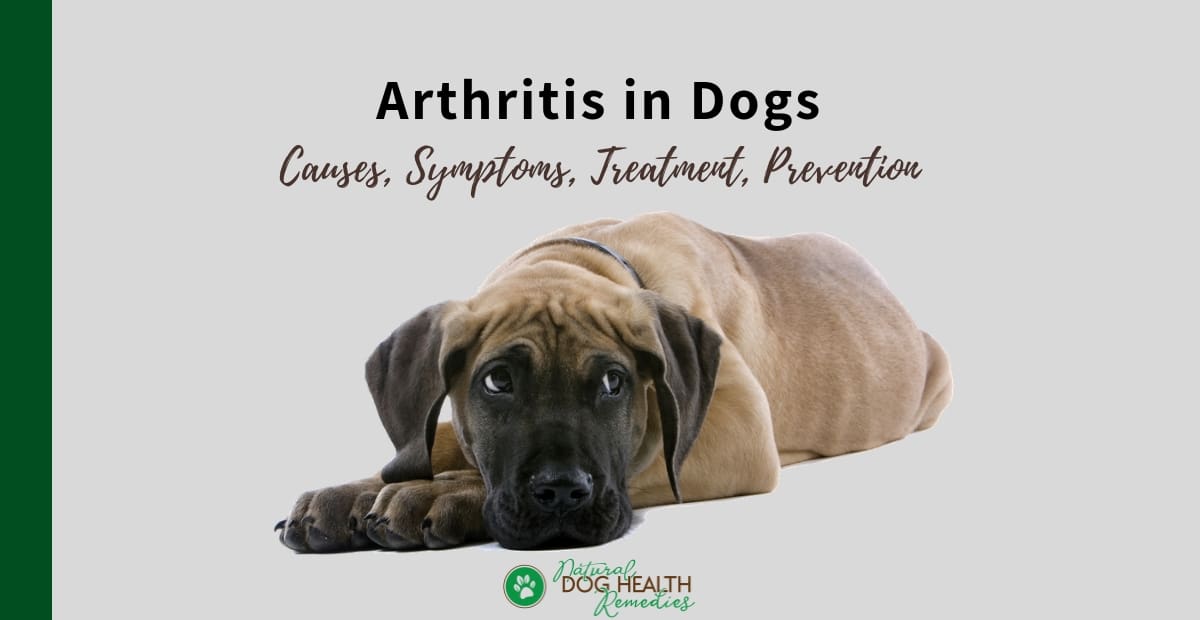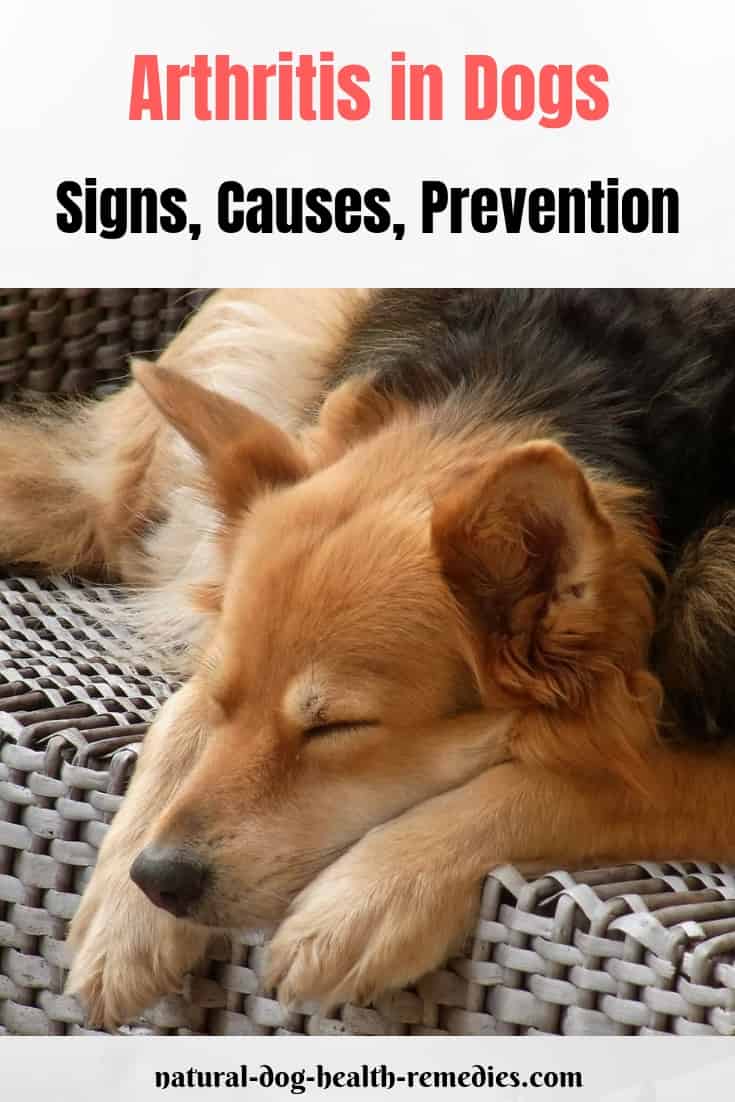Dog Arthritis Symptoms and Treatment
(FTC Disclosure: If you make a purchase via a link on this page, I may receive a small commission, at no added cost to you.)

Overview
Although many people associate arthritis with old age, not-too-old dogs can also be affected by this problem. In fact, 65% of dogs over 6 years old show some signs.
Dog arthritis is a debilitating and painful disease. It can adversely affect your four-legged friend's comfort, lifestyle, and emotional wellbeing.
Fortunately, there are many ways to prevent and treat arthritis holistically, allowing our dogs to enjoy better quality of life for a longer period of time.
What Causes Arthritis in Dogs?
If we look at a bony joint anatomically, we can see cartilage which is the soft tissue that covers the ends of the bones.
We can also see synovial fluid which is made up of a mixture of water and proteins and which fills the joint space. The fluid lubricates the cartilage and allows it to slide.
Then there are ligaments, which hold the cartilage together, and help keep the synovial fluid in the space between the bones.
Arthritis is the result of a breakdown of the cartilage.
When the cartilage is damaged, whether from trauma or aging, it leads to inflammation and pain resulting from bones rubbing together.
Are Some Dogs More At Risk?
All dogs can develop arthritis, but there are some risk factors:
- Size of the Dog: Usually, large-breed dogs and obese dogs are more prone to degenerative joint issues.
- Age of the Dog: The older the dog, the higher the risk of developing arthritis.
- Genetics: Some dogs are more genetically prone to joint abnormalities (e.g. Golden retrievers are susceptible to hip dysplasia.)
- Diet: If a dog's diet contains a lot of foods that cause inflammation (e.g. corn, sugar, processed meat), chances are he will develop inflammatory conditions (e.g. arthritis) down the road.
Types of Dog Arthritis
There are many types of arthritis in dogs, but we can break them down into two main types: rheumatoid arthritis and osteoarthritis.
Canine rheumatoid arthritis is an autoimmune disease. The body attacks the joint tissues resulting in stiffness, inflammation and pain. Multiple joints (such as shoulders, wrists, ankles, knees) can be affected.
Osteoarthritis (also called degenerative joint disease) is the degeneration of the joint cartilage caused by old age, poor nutrition, chronic trauma to the joints, or accumulation of free radicals in the body.
Canine osteoarthritis is rather common and accounts for approximately 90% of arthritis treated by veterinarians.
Osteoarthritis in dogs can manifest itself in the following main ways:
- Hip Dysplasia: Hip dysplasia is a poor development of the hip joint in dogs. Dogs with hip dysplasia have a hip socket that is shallow and the the ball on the thigh bone is flattened. This causes excessive movement in the joint, causing chronic inflammation and calcium deposition.
- Dislocation of the Knee-cap: Dislocation of the knee-cap (medically known as patella luxation) is one of the most common problems with small breed dogs such as the Chihuahua and Pomeranians.
This is a hereditary problem. It is caused by a malformation of the leg bones resulting in the kneecap being repeatedly pulled out of position.
The dog will show signs of this condition only when the knee cap is sliding out of place. You will see the dog limping or running with the affected leg held off the ground, and he will often stretch it out behind him in an effort to click the cartilage back into place.
It is also likely to be painful particularly if the kneecap is out of joint.
If it is not corrected through surgery, then osteoarthritis will usually result.
- Degeneration of the Shoulder Joint: More common in medium to large breeds, degeneration of the shoulder joint is caused by a breakdown of the cartilage in the shoulder, resulting in inflammation and joint pain.
- Septic Arthritis: Septic arthritis is an infection of the joint space. It can occur after an injury, or if bacteria from a pneumonia, for instance, spreads through the blood and lodges in a joint. Permanent damage can occur if not treated quickly.
Symptoms of Dog Arthritis
Signs and symptoms of arthritis in dogs include:
- Lethargy
- Afraid to be touched, especially along the spine or the affected limb
- Excessive licking of the affected area
- Walking with a limp
- Stiffness, especially after rest
- Difficulty in climbing stairs
- Difficulty in climbing in and out of a car
- Swelling and/or tenderness in limb or spine
- Loss of appetite
- Irritability
However, please bear in mind that animals can endure pain much more than we can, so sometimes they may already have developed arthritis for a while before showing the above symptoms.
Also, since dogs are playful and eager to please, your dog may still want to chase and catch that ball just to please you even though he may have pain in his squeaky joints.
The bottom line? Be more observant to your dog's behavior. If you notice any slight behavioral change in your dog, watch him more closely. Also, exercise a little educated judgment.
Conventional Treatment of Dog Arthritis
Conventional treatment usually involves the use of arthritis medication, such as steroids, NSAIDs, to get rid of the symptoms without actually curing the disease. In certain cases, surgery is needed to repair damaged joints.
Research has shown that continuous use of arthritis drugs can cause numerous side effects in our pets, such as stomach ulcers, as well as liver and kidney problems.
Conventional medications can also worsen an arthritic dog's condition because long-term use is harmful to cartilage, and prolonged corticosteroid (Predinsone) use often produces weight gain, further stressing damaged joints.
Having said that, don't write off conventional medications totally because they can provide faster pain relief to your dog. If your dog has very serious arthritis and joint pain, consider using these medicines short-term to help your dog feel better quicker.
Read more about conventional arthritis medication for dogs on this page.
Alternative Treatment for Dog Arthritis and Joint Problems
Dogs with arthritis need the professional care of veterinarians. However, it doesn't mean that we cannot use some safe and natural remedies to relieve the pain caused by arthritis, as well as to strengthen and protect the cartilage and joints so that the arthritic condition does not deteriorate drastically.
If your dog has been diagnosed with joint problems, discuss with your vet the possibility of using holistic treatments instead of, or in conjunction with, drug therapy. Consult a holistic vet if necessary.
Please also visit our page on Natural Remedies for Arthritis to find out more about using herbs and other supplements to treat dog arthritis.
Preventive Care for Your Arthritic Dog
To prevent arthritis in your dog, or if arthritis has already set in, to prevent it from deterioriating further, pay attention to the following:
Diet
A healthy and natural diet is essential especially when your pet is pregnant to ensure that her babies have all the nutrients needed for the proper formation of joint and and other structural tissues.
Some foods have been found to aggravate arthritis in dogs and should be avoided if your dog is showing signs of arthritis. Some such foods include:
- Grains
- Potatoes (not sweet potatoes)
- Tomatoes
- Peppers
- Eggplant
On the other hands, certain foods may help with dog arthritis. For example:
- Celery
- Ginger
- Alfalfa
- Parsley
- Turmeric
- Garlic
- Tropical fruits (e.g. mango, papaya)
- Cartilage
- Organic apple cider vinegar
If you can prepare a homemade dog diet for your arthritic dog, so much the better since you have total control of which ingredients to include. However, if you are not able to provide home cooked food to your dog, find a high-quality, grain-free natural diet, preferably containing some of the ingredients that may help with arthritis as listed above.
Weight Control
 Excessive weight can put extra stress and burden on your dog's joints, so obesity is one of the causes of arthritis in dogs.
Excessive weight can put extra stress and burden on your dog's joints, so obesity is one of the causes of arthritis in dogs.
Dogs with hip dysplasia and are obese are at very high risk for chronic arthritis in the hips. So be sure to control your dog's weight through proper exercise and dietary management. Do not overfeed your dog!
Many dog parents see an improvement in their dogs just by simply switching over to a high-quality, natural diet, and dropping a few pounds.
Exercise
Too little exercise causes the affected joints to stiffen, while too much activity intensifies pain and reduces healing. A good balance is taking regular short walks, maybe 2 to 3 times a day.
Lifestyle
If your dog has started showing signs of arthritis, you should make some simple changes around the home so as to make life easier for your dog. Here are some of the things that you may consider getting for your dog:
- Pet Ramps or Steps: A pet ramp makes getting in or out of a car much easier. It can also prevent stress-related injuries that can occur when your dog jump down onto his front legs.
- Elevated Food and Water Bowls: Raising food and water bowls so your dog does not have to bend is a simple trick that dramatically increases comfort, especially if the spine and neck are affected.
- Orthopedic beds: These special beds are designed to conform to a dog's body, thereby reducing pressure on sensitive areas. This decreases stiffness and eases pain. Those with heat compound the effect - warmth gently increases blood flood and soothes affected joints.
- Keep Your Dog Warm: Cold weather and environment can stiffen affected joints and decrease mobility. A warm environment and place to rest keeps joints loose and reduces pain. Move your dog's bed away from draft and put a sweater on your dog in the winter before going outside.
- Baths: Your dog may not welcome taking a bath too much, but short soaks with mineral salts, or herbs like oat straw can sooth painful areas.
- Massage: Using essential oils to
gently massage affected areas increases blood flow, which reduces pain and aids healing.
Essential oils like ginger, helichrysum, peppermint, and eucalyptus reduce pain and inflammation. Always dilute the essential oils with a high-quality massage carrier oil, and always allow your dog to smell the oil and give his okay before applying.
Another plus of massaging your dog is regular massage allows you to discover tumors or signs of other medical problems at very early, treatable stages.
Eldredge, et al. Dog Owner's Home Veterinary Handbook 4th edition (Wiley Publishing, 2007).
R.H. Pitcairn, The Complete Guide to Natural Health for Dogs and Cats (Rodale, 2005).
K. Schulz, DVM, The Pet Lover's Guide to Canine Arthritis & Joint Problems (Saunders Elsevier, 2006).
W.J. Dodds, D.R. Laverdue, Canine Nutrigenomics - The New Science of Feeding Your Dog for Optimum Health (Dogwise Publishing, 2015).





